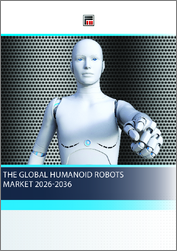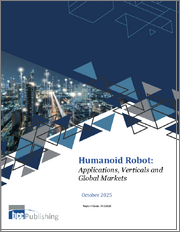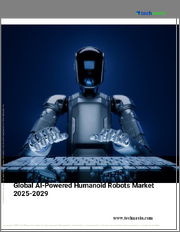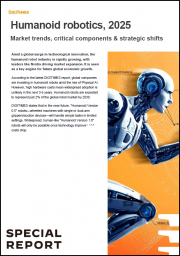
|
시장보고서
상품코드
1772628
세계의 휴머노이드 로봇 시장(2026-2036년)The Global Humanoid Robots Market 2026-2036 |
||||||
휴머노이드 로봇 시장은 AI 분야의 획기적인 발전과 하드웨어 기능의 급속한 향상으로 인해 투자자들의 열정과 기술적 모멘텀이 그 어느 때보다 높아졌으며, 2024년 로봇 관련 스타트업은 시드에서 성장 단계까지 약 72억 달러의 투자를 확보했습니다. 이러한 투자의 물결은 휴머노이드 로봇이 실험적인 기술에서 실현 가능한 상업적 제품으로 전환되고 있다는 믿음이 커지고 있음을 반영합니다.
최근 몇 년간의 자금 조달 움직임은 이 부문의 폭발적인 성장 가능성을 보여주고 있습니다. '범용 휴머노이드를 세상에 내놓는 것'에 전념하는 창업 2년차 스타트업인 피규어(Figure)는 지난 2월 시리즈 B에서 6억 7,500만 달러(한화 약 7,000억 원)의 투자를 유치하며 위험하고 원치 않는 일을 하는 로봇을 만들겠다는 비전을 더욱 구체화했습니다. 올해 설립된 샌프란시스코의 스타트업 Physical Intelligence는 20억 달러의 평가액으로 4억 달러의 투자를 유치했습니다. Apptronik은 구글을 포함한 주요 기업의 후원으로 AI를 탑재한 휴머노이드 로봇의 생산 규모를 확대하기 위해 3억 5,000만 달러의 Series A 펀딩 라운드를 발표하며 자금 조달 모멘텀을 이어가고 있습니다. 이외에도 Fourier가 Series E 펀딩 라운드에서 약 8억 위안(약 1억 910만 달러), NEURA Robotics가 Series B 펀딩 라운드에서 1억 2,000만 유로를 조달하는 등 2025년 중요한 자금 조달이 이루어지고 있습니다.
기술력이 예상을 뛰어넘어 시장 예측이 크게 상향 조정되었습니다. 중요한 기술 발전이 시장 채택을 가속화하고 있습니다. 제조비용은 예상보다 빠른 속도로 하락하고 있습니다. 휴머노이드 로봇의 제조비용은 지난해 대당 5만 달러에서 25만 달러에서 현재 3만 달러에서 15만 달러로 낮아졌으며, 이는 연간 15-20% 감소할 것으로 예상했던 것과 비교하면 40%나 감소한 것입니다. 휴머노이드 로봇 개발의 대표주자이며, 휴머노이드 로봇을 양산할 계획으로 2026년까지 5만 대-10만 대라는 야심찬 성장 목표를 예측했습니다.
AI의 발전, 제조 규모, 긴급한 노동 시장 요구가 결합되면서 휴머노이드 로봇은 폭발적으로 성장하여 제조, 물류, 의료, 그리고 궁극적으로 소비자 시장에까지 적용될 것입니다. 기술적 과제는 남아있지만, 전례 없는 투자 수준과 빠른 기술 발전으로 인해 휴머노이드 로봇은 10년 이내에 여러 산업을 변화시킬 것으로 보입니다.
세계 제조, 의료, 서비스 산업에서 인력 부족이 심화되고 있는 가운데, 휴머노이드 로봇은 인간의 개입이 필요했던 위험하고 반복적이며 복잡한 작업을 수행할 수 있는 혁신적인 솔루션으로 부상하고 있습니다. 첨단 AI 알고리즘, 정교한 센서 기술, 에너지 효율적인 전력 관리 시스템이 결합되면서 휴머노이드 플랫폼의 상업적 실현 가능성이 가속화되고 있으며, 이 시장은 향후 10년간 엄청난 확장을 보일 것으로 예측됩니다.
세계 휴머노이드 로봇 시장에 대해 조사 분석했으며, 시장 역학, 기술 혁신, 경쟁 환경, 전략적 기회에 대한 중요한 통찰력을 제공합니다.
목차
제1장 서론
- 휴머노이드 로봇 : 정의와 특징
- 연혁과 진화
- 휴머노이드 로봇 현황(2025년)
- 휴머노이드 로봇 중요성
- 시장과 용도(TRL)
- 상업 개발 모델과 단계
- 투자 및 자금조달
- 비용
- 시장 성장 촉진요인
- 과제
- 세계의 규제
- 일본 시장
- 미국 시장
- 중국 시장
제2장 기술과 컴포넌트 분석
- 휴머노이드 로봇 설계 진보
- 중요 컴포넌트
- 인텔리전트 제어 시스템과 최적화
- 첨단 로보틱스와 자동화
- 제조
- 브레인 컴퓨터 인터페이스
- 로보틱스와 인텔리전트 헬스
- 마이크로/나노로봇
- 의료·재활치료 로봇
- 메카트로닉스와 로보틱스
- 영상 처리, 로보틱스, 인텔리전트 비전
- AI와 머신러닝
- 센서와 인식 기술
- 전력 및 에너지 관리
- 액추에이터
- 모터
- 감속기
- 나사
- 베어링
- 암 이펙터
- 휴머노이드 로봇 용SoC
- 클라우드 로보틱스와 로봇 인터넷(IoRT)
- 휴먼 로봇 인터랙션(HRI)과 소셜 로보틱스
- 생체 모방 설계
- 휴머노이드 로봇 용재료
- 피부 조직 결합
제3장 최종 용도 시장
- 시장 공급망
- 상업화 레벨
- 의료 및 지원
- 교육 및 연구
- 고객 서비스 및 호스피탈리티
- 엔터테인먼트 및 레저
- 제조 및 산업
- 군 및 방위
- 개인 사용 및 가정환경
제4장 세계 시장 규모(대수와 매출)(2024년-2036년)
- 세계의 출하대수(합계)
- 대수 : 로봇 유형별
- 대수 : 지역별
- 매출(합계)
- 매출 : 최종 용도 시장별
- 자동차
- 물류 및 창고
- 배터리 용량(GWh) 예측
- 하드웨어 컴포넌트
제5장 기업 개요(기업 80개사 개요)
제6장 학술계가 개발한 휴머노이드 로봇
제7장 조사 방법
제8장 참고 문헌
LSH 25.07.28The humanoid robots market is experiencing unprecedented investor enthusiasm and technological momentum, driven by breakthrough developments in artificial intelligence and rapidly improving hardware capabilities. Altogether, robotics-related startups secured around $7.2 billion in seed- through growth-stage investments in 2024. This investment wave reflects growing confidence that humanoid robots are transitioning from experimental technology to viable commercial products.
Recent funding activity demonstrates the sector's explosive growth potential. Figure, a 2-year-old startup dedicated to "bringing a general purpose humanoid to life," pulled in $675 million in Series B funding in February to further its vision of building robots to perform unsafe and undesirable jobs. Physical Intelligence, the San Francisco start-up, founded just this year, pulled in $400 million at a $2 billion valuation. The funding momentum continues with Apptronik announcing a $350 million Series A funding round to scale the production of artificial intelligence-powered humanoid robots, backed by major players including Google. Other significant 2025 funding includes Fourier's Series E funding round securing nearly Yen-800 million (about $109.1 million) and NEURA Robotics raising Euro-120 million in a Series B funding round.
Market forecasts have been dramatically revised upward as technology capabilities exceed expectations. Critical technological advances are accelerating market adoption. Manufacturing costs are declining faster than expected: The manufacturing cost of humanoid robots has dropped from a range between $50,000 and $250,000 per unit last year, to a range of between $30,000 and $150,000 now, with costs declining 40% rather than the expected 15-20% per annum. Tesla's Optimus program represents the highest-profile humanoid robot development, with plans to mass produce its humanoid robot, with ambitious growth targets predicting between 50,000 and 100,000 units by 2026.
The convergence of AI advancement, manufacturing scale, and urgent labor market needs positions humanoid robots for explosive growth, with applications spanning manufacturing, logistics, healthcare, and eventually consumer markets. While technical challenges remain, the unprecedented investment levels and rapid technological progress suggest humanoid robots are poised to transform multiple industries within the current decade.
The global humanoid robotics market stands at the precipice of explosive growth, driven by unprecedented advancements in artificial intelligence, machine learning capabilities, and breakthrough developments in robotic hardware systems. "The Global Humanoid Robotics Market 2026-2036" provides an exhaustive analysis of the humanoid robotics industry, delivering critical insights into market dynamics, technological innovations, competitive landscapes, and strategic opportunities spanning the forecast period from 2026 to 2036. As labour shortages intensify across manufacturing, healthcare, and service industries worldwide, humanoid robots emerge as transformative solutions capable of performing dangerous, repetitive, and complex tasks previously requiring human intervention. The convergence of advanced AI algorithms, sophisticated sensor technologies, and energy-efficient power management systems has accelerated the commercial viability of humanoid platforms, positioning this market for extraordinary expansion over the next decade.
This authoritative report examines the complete humanoid robotics ecosystem, from foundational component technologies including actuators, sensors, power systems, and intelligent control mechanisms to end-use applications across healthcare assistance, education research, customer service, entertainment, manufacturing automation, logistics operations, military defence, and domestic personal use. The analysis encompasses detailed technology readiness level assessments, market driver evaluations, commercial development timelines, and comprehensive cost evolution projections that illuminate the pathway toward mainstream adoption.
Report Contents:
- Market Size and Growth Projections: Conservative and optimistic revenue forecasts through 2036, with detailed unit shipment analysis by robot type (bipedal vs. wheeled platforms) and regional market distribution across Asia-Pacific, North America, Europe, and emerging markets
- Technology Analysis: Comprehensive examination of critical components including advanced actuator systems, reducer technologies, sensor fusion capabilities, AI hardware/software integration, power management solutions, thermal control systems, and biomimetic design principles
- Component Cost Evolution: Detailed breakdown of hardware component costs including actuators, sensors, processing units, battery systems, structural materials, and end effectors, with year-over-year cost reduction projections and manufacturing scale impact analysis
- End-Use Market Assessment: Granular analysis of application segments including healthcare robotics, educational platforms, hospitality automation, entertainment systems, industrial manufacturing, automotive assembly, logistics warehousing, military applications, and domestic assistance robots
- Investment and Funding Landscape: Comprehensive overview of venture capital investments, funding rounds, strategic partnerships, and government initiatives driving market development across major geographic regions
- Regulatory Framework Analysis: Global regulatory landscape examination covering safety standards, certification requirements, liability frameworks, and policy developments influencing commercial deployment timelines
- Competitive Intelligence: Detailed market positioning analysis, technology benchmarking, commercial development status, and strategic initiatives of leading humanoid robotics companies
- Manufacturing Challenges: In-depth assessment of production bottlenecks, supply chain constraints, quality assurance requirements, and scalability obstacles facing mass commercialization
- Advanced Technologies: Cutting-edge developments in brain-computer interfaces, cloud robotics integration, human-robot interaction protocols, biomimetic materials, wireless power transfer, energy harvesting systems, and next-generation sensor technologies
- Academic Research Overview: Comprehensive survey of university-based humanoid robot development programs and emerging research directions influencing commercial applications
The report features comprehensive profiles of 80 leading humanoid robotics companies including 1X Technologies, AeiRobot, Aeolus Robotics, Agibot, Agility Robotics, Andromeda, Apptronik, Axibo, Baidu, Beyond Imagination, Boardwalk Robotics, Booster Robotics, Boston Dynamics, BridgeDP Robotics, BXI Robotics, Clone Robotics, Dataa Robotics, Devanthro, Diligent Robotics, Dreame Technology, Electron Robots, Elephant Robotics, Embodied Inc., Enchanted Tools, Engineered Arts, EX Robots, FDROBOT, Figure AI, Foundation, Fourier Intelligence, Furhat Robotics, Galbot, Generation Robots, Hanson Robotics, Holiday Robotics, Honda, Humanoid, Kawada Robotics, Kawasaki Heavy Industries, Keenon Robotics, Kepler, K-Scale Labs, Leju Robotics, LimX Dynamics, Macco Robotics, MagicLab, Mentee Robotics, and more, providing detailed analysis of their technology platforms, commercial strategies, funding status, and market positioning within the rapidly evolving humanoid robotics landscape.
TABLE OF CONTENTS
1. INTRODUCTION
- 1.1. Humanoid Robots: Definition and Characteristics
- 1.2. Historical Overview and Evolution
- 1.3. Current State of Humanoid Robots in 2025
- 1.4. The Importance of Humanoid Robots
- 1.5. Markets and Applications (TRL)
- 1.6. Models and Stage of Commercial Development
- 1.7. Investments and Funding
- 1.8. Costs
- 1.8.1. Type
- 1.8.2. Components
- 1.8.3. Cost Evolution
- 1.9. Market Drivers
- 1.9.1. Advancements in Artificial Intelligence (AI) and Machine Learning (ML)
- 1.9.2. Labour force shortages
- 1.9.3. Labour force substitution
- 1.9.4. Need for Personal Assistance and Companionship
- 1.9.5. Exploration of Hazardous and Extreme Environments
- 1.10. Challenges
- 1.10.1. Commercial Challenges
- 1.10.2. Technical Challenges
- 1.11. Global regulations
- 1.12. Market in Japan
- 1.13. Market in United States
- 1.14. Market in China
2. TECHNOLOGY AND COMPONENT ANALYSIS
- 2.1. Advancements in Humanoid Robot Design
- 2.2. Critical Components
- 2.3. Intelligent Control Systems and Optimization
- 2.4. Advanced Robotics and Automation
- 2.5. Manufacturing
- 2.5.1. Design and Prototyping
- 2.5.2. Component Manufacturing
- 2.5.3. Assembly and Integration
- 2.5.4. Software Integration and Testing
- 2.5.5. Quality Assurance and Performance Validation
- 2.5.6. Challenges
- 2.5.6.1. Actuators
- 2.5.6.2. Reducers
- 2.5.6.3. Thermal management
- 2.5.6.4. Batteries
- 2.5.6.5. Cooling
- 2.5.6.6. Sensors
- 2.6. Brain Computer Interfaces
- 2.7. Robotics and Intelligent Health
- 2.7.1. Robotic Surgery and Minimally Invasive Procedures
- 2.7.2. Rehabilitation and Assistive Robotics
- 2.7.3. Caregiving and Assistive Robots
- 2.7.4. Intelligent Health Monitoring and Diagnostics
- 2.7.5. Telemedicine and Remote Health Management
- 2.7.6. Robotics in Mental Health
- 2.8. Micro-nano Robots
- 2.9. Medical and Rehabilitation Robots
- 2.10. Mechatronics and Robotics
- 2.11. Image Processing, Robotics and Intelligent Vision
- 2.12. Artificial Intelligence and Machine Learning
- 2.12.1. Overview
- 2.12.2. AI Hardware and Software
- 2.12.2.1. Functions
- 2.12.2.2. Simulation
- 2.12.2.3. Motion Planning and Control
- 2.12.2.4. Foundation Models
- 2.12.2.5. Synthetic Data Generation
- 2.12.2.6. Multi-contact planning and control
- 2.12.3. End-to-end AI
- 2.12.4. Multi-modal AI algorithms
- 2.13. Sensors and Perception Technologies
- 2.13.1. Vision Systems
- 2.13.1.1. Commerical examples
- 2.13.2. Hybrid LiDAR-camera approaches
- 2.13.3. Cameras and LiDAR
- 2.13.3.1. Cameras (RGB, depth, thermal, event-based)
- 2.13.3.2. Stereo vision and 3D perception
- 2.13.3.3. Optical character recognition (OCR)
- 2.13.3.4. Facial recognition and tracking
- 2.13.3.5. Gesture recognition
- 2.13.3.6. mmWave Radar
- 2.13.4. Tactile and Force Sensors
- 2.13.4.1. Value proposition of advanced tactile systems
- 2.13.4.2. Commercial examples
- 2.13.4.3. Flexible tactile sensors
- 2.13.4.4. Tactile sensing for humanoid extremities
- 2.13.4.5. Tactile sensors (piezoresistive, capacitive, piezoelectric)
- 2.13.4.6. Force/torque sensors (strain gauges, load cells)
- 2.13.4.7. Haptic feedback sensors
- 2.13.4.8. Skin-like sensor arrays
- 2.13.5. Auditory Sensors
- 2.13.5.1. Microphones (array, directional, binaural)
- 2.13.5.2. Sound Localization and Source Separation
- 2.13.5.3. Speech Recognition and Synthesis
- 2.13.5.4. Acoustic Event Detection
- 2.13.6. Inertial Measurement Units (IMUs)
- 2.13.6.1. Accelerometers
- 2.13.6.2. Gyroscopes
- 2.13.6.3. Magnetometers
- 2.13.6.4. Attitude and Heading Reference Systems (AHRS)
- 2.13.7. Proximity and Range Sensors
- 2.13.7.1. Ultrasonic sensors
- 2.13.7.2. Laser range finders (LiDAR)
- 2.13.7.3. Radar sensors
- 2.13.7.4. Time-of-Flight (ToF) sensors
- 2.13.8. Environmental Sensors
- 2.13.8.1. Temperature sensors
- 2.13.8.2. Humidity sensors
- 2.13.8.3. Gas and chemical sensors
- 2.13.8.4. Pressure sensors
- 2.13.9. Biometric Sensors
- 2.13.9.1. Heart rate sensors
- 2.13.9.2. Respiration sensors
- 2.13.9.3. Electromyography (EMG) sensors
- 2.13.9.4. Electroencephalography (EEG) sensors
- 2.13.10. Sensor Fusion
- 2.13.10.1. Kalman Filters
- 2.13.10.2. Particle Filters
- 2.13.10.3. Simultaneous Localization and Mapping (SLAM)
- 2.13.10.4. Object Detection and Recognition
- 2.13.10.5. Semantic Segmentation
- 2.13.10.6. Scene Understanding
- 2.13.1. Vision Systems
- 2.14. Power and Energy Management
- 2.14.1. Battery Technologies
- 2.14.2. Challenges
- 2.14.3. Energy Harvesting and Regenerative Systems
- 2.14.3.1. Energy Harvesting Techniques
- 2.14.3.2. Regenerative Braking Systems
- 2.14.3.3. Hybrid Power Systems
- 2.14.4. Power Distribution and Transmission
- 2.14.4.1. Efficient Power Distribution Architectures
- 2.14.4.2. Advanced Power Electronics and Motor Drive Systems
- 2.14.4.3. Distributed Power Systems and Intelligent Load Management
- 2.14.5. Thermal Management
- 2.14.5.1. Cooling Systems
- 2.14.5.2. Thermal Modeling and Simulation Techniques
- 2.14.5.3. Advanced Materials and Coatings
- 2.14.6. Energy-Efficient Computing and Communication
- 2.14.6.1. Low-Power Computing Architectures
- 2.14.6.2. Energy-Efficient Communication Protocols and Wireless Technologies
- 2.14.6.3. Intelligent Power Management Strategies
- 2.14.7. Wireless Power Transfer and Charging
- 2.14.8. Energy Optimization and Machine Learning
- 2.15. Actuators
- 2.15.1. Humanoid robot actuation systems
- 2.15.2. Actuators in humanoid joint systems
- 2.15.3. Energy transduction mechanism
- 2.16. Motors
- 2.16.1. Overview
- 2.16.2. Frameless motors
- 2.16.3. Brushed/Brushless Motors
- 2.16.4. Coreless motors
- 2.17. Reducers
- 2.17.1. Harmonic reducers
- 2.17.2. RV (Rotary Vector) reducers
- 2.17.3. Planetary gear systems
- 2.18. Screws
- 2.18.1. Screw-based transmission systems
- 2.18.2. Ball screw assemblies
- 2.18.3. Planetary Roller Screws
- 2.19. Bearings
- 2.19.1. Overview
- 2.20. Arm Effectors
- 2.20.1. Overview
- 2.20.2. Hot-swappable end effector systems
- 2.20.3. Challenges
- 2.21. SoCs for Humanoid Robotics
- 2.22. Cloud Robotics and Internet of Robotic Things (IoRT)
- 2.23. Human-Robot Interaction (HRI) and Social Robotics
- 2.24. Biomimetic and Bioinspired Design
- 2.25. Materials for Humanoid Robots
- 2.25.1. New materials development
- 2.25.2. Metals
- 2.25.2.1. Magnesium Alloy
- 2.25.3. Shape Memory Alloys
- 2.25.4. Plastics and Polymers
- 2.25.5. Composites
- 2.25.6. Elastomers
- 2.25.7. Smart Materials
- 2.25.8. Textiles
- 2.25.9. Ceramics
- 2.25.10. Biomaterials
- 2.25.11. Nanomaterials
- 2.25.12. Coatings
- 2.25.12.1. Self-healing coatings
- 2.25.12.2. Conductive coatings
- 2.26. Binding Skin Tissue
3. END USE MARKETS
- 3.1. Market supply chain
- 3.2. Level of commercialization
- 3.3. Healthcare and Assistance
- 3.4. Education and Research
- 3.5. Customer Service and Hospitality
- 3.6. Entertainment and Leisure
- 3.7. Manufacturing and Industry
- 3.7.1. Overview
- 3.7.1.1. Assembly and Production
- 3.7.1.2. Quality Inspection
- 3.7.1.3. Warehouse Assistance
- 3.7.2. Automotive
- 3.7.2.1. Commercial examples
- 3.7.3. Logistics
- 3.7.3.1. Warehouse environments
- 3.7.3.2. Commercial examples
- 3.7.1. Overview
- 3.8. Military and Defense
- 3.9. Personal Use and Domestic Settings
4. GLOBAL MARKET SIZE (UNITS AND REVENUES) 2024-2036
- 4.1. Global shipments in units (Total)
- 4.2. By type of robot in units
- 4.3. By region in units
- 4.4. Revenues (Total)
- 4.5. Revenues (By end use market)
- 4.6. Automotive
- 4.6.1. Revenues
- 4.6.2. Units
- 4.6.3. Deployment
- 4.7. Logistics and warehousing
- 4.7.1. Revenues
- 4.7.2. Units
- 4.7.3. Deployment
- 4.8. Battery Capacity (GWh) Forecast
- 4.9. Hardware Components



















